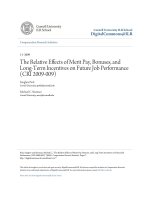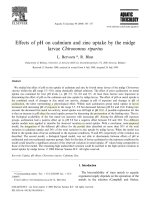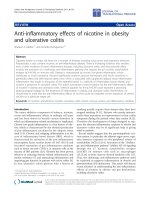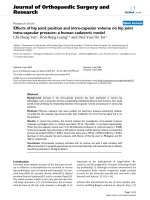Coupling effects of NaYF4Yb,Er upconversion nanoshells and au ag metallic nanoshells 6
Bạn đang xem bản rút gọn của tài liệu. Xem và tải ngay bản đầy đủ của tài liệu tại đây (100.48 KB, 3 trang )
103
Chapter 6 Conclusions and Recommendations
6.1 Conclusions
In this thesis, I demonstrated the effects of surface, surface coatings,
and plasmonic effects of metallic nanoshells on the fluorescence of the UC
nanoshells. The results showed the UC fluorescence enhancement could be
achieved by surface coatings and plasmonic effects.
UC nanoshells with hcp crystal structure were successfully
synthesized. The interior cavity and UC shell thickness were ~7 nm and ~4
nm, respectively. The effects of surface on the fluorescence of the UC
nanoshells were investigated. The results demonstrated the total emission
intensity of the UC nanoshells significantly decreased when compared to that
of the corresponding solid nanoparticles (~15 nm) since the nanoshells had a
higher UC active volume-normalized surface area. However, it was
demonstrated that the total emission intensity of the UC nanoshells could
significantly be increased by surface coatings of undoped NaYF
4
. The surface
coatings of ~3 nm undoped NaYF
4
on both the inner and outer surfaces of the
UC nanoshells led to an emission enhancement to ~19 and ~5 times compared
to that of the UC nanoshells and the solid UC (~15 nm) nanoparticles,
respectively.
To study the plasmonic effects on the fluorescence properties of UC
nanoshells, Au-Ag metallic nanoshells were synthesized via galvanic
replacement reaction between Ag templates and HAuCl
4
. The shell thickness
of the Au–Ag nanoshells was controlled by HAuCl
4
concentration. The shell
thickness increased from ~5 nm to ~10 nm for the equiaxed Au-Ag nanoshells
104
(~39-nm interior cavity) and ~5 nm to ~8 nm for the triangular prismatic Au-
Ag nanoshells (~52-nm interior edge length). Their LSPR extinction peak was
tunable from ~670 nm to ~840 nm. Investigations on the nanoshell formation
showed the transformation from Ag templates to Au-Ag nanoshells was size-
dependent.
The assembly of Au-Ag nanoshell layer/silica film/UC nanoshell layer
was prepared to investigate the plasmonic effects of Au-Ag nanoshells on the
fluorescence of UC nanoshells. This study showed the fluorescence of the UC
nanoshells was either enhanced or quenched by Au-Ag nanoshells, depending
on the silica film thickness and the surface coverage % of the Au-Ag
nanoshell layer in the assembly. For fixed silica thickness, the UC
fluorescence showed nonlinear changes with the surface coverage of Au-Ag
nanoshells. At Au-Ag surface coverage lower than 22%, the total UC
emission intensity increased with the surface coverage % due to the increase
of local field intensity enhancement. However, when the surface coverage of
Au-Ag nanoshell layer further increased from 22% to 46%, the UC
fluorescence intensity decreased due to the photothermal effects of Au-Ag
nanoshells.
For the assembly with a fixed surface coverage of Au-Ag nanoshell
layer, the transitions from UC fluorescence quenching to enhancement and
subsequent unenhanced UC emission intensity were observed with increasing
thickness of silica film. This study demonstrated a maximum UC fluorescence
enhancement could be obtained by controlling the distance from Au-Ag
nanoshells to UC nanoshells and the surface coverage % of Au-Ag nanoshell
layer.
105
6.2 Recommendations for future study
This work showed the surface effects of UC nanoshells significantly
decreased the UC emission intensity compared with their solid nanoscale
counterparts. By using the protection of undoped NaYF
4
shells and plasmonic
effects, their UC emission intensities could be enhanced. However, these
enhanced emission intensities of nanostructures were still only ~1 – 5 %
compared with that of their solid bulk counterparts. Thus, it warrants further
study for the emission enhancement, for example, using more efficient host
and investigation on the distribution of Yb and Er ions in NaYF
4
host.
The UC nanoshells had the interior cavity ~7 nm and shell thickness
~4 nm, making it a good object to study the surface effects due to their large
surface area. The formation mechanism of the UC nanoshells involved
vacancy diffusion, likely due to the Kirkendall effect and Ostwald ripening
mechanism. However, the diffusion of ions in the host during the formation of
such small nanoshells is not yet well-understood yet. The diffusion of ions
should be investigated in future study.
This study demonstrated the concentration and distance dependences
of plasmon-enhanced UC fluorescence. An optimum fluorescence
enhancement was obtained by controlling the distance between the UC
nanoshells and Au-Ag nanoshells and the concentration of Au-Ag nanoshells
on the substrates. However, the UC fluorescence quenching efficiency due to
non-radiative losses to Au-Ag nanoshells was not quantitatively measured
because of the complex UC process. Further study should investigate the
concentration- and distance-dependent non-radiative losses.









